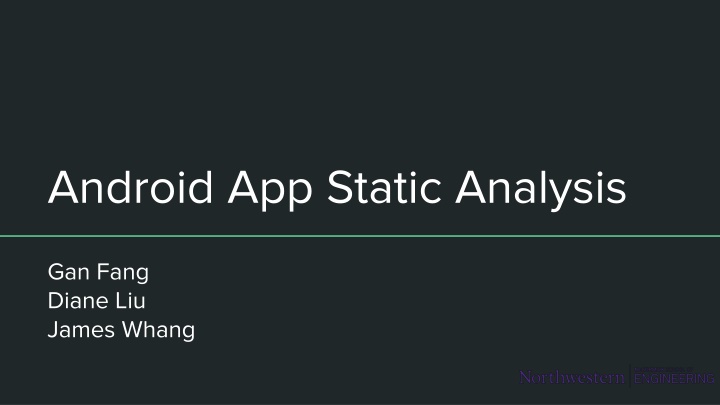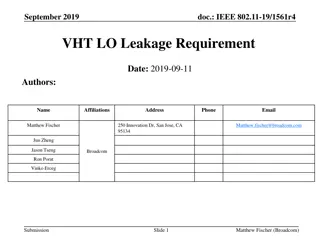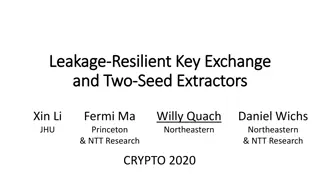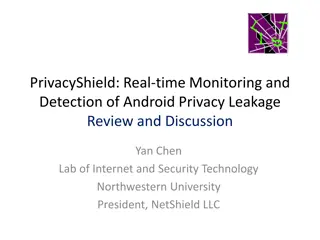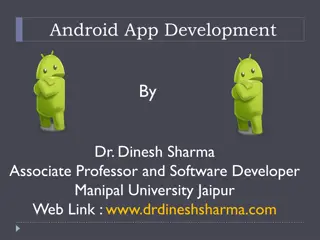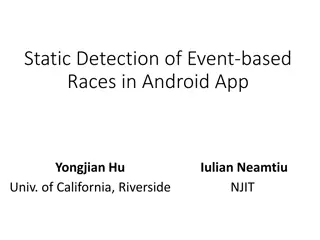Android Security and Information Leakage Analysis
Android has a dominant market share with security concerns such as data leakage and privacy violations. This analysis delves into the background of Android information leakage, static analysis, taint analysis, and the motivations behind enhancing security measures in Android apps.
Download Presentation

Please find below an Image/Link to download the presentation.
The content on the website is provided AS IS for your information and personal use only. It may not be sold, licensed, or shared on other websites without obtaining consent from the author.If you encounter any issues during the download, it is possible that the publisher has removed the file from their server.
You are allowed to download the files provided on this website for personal or commercial use, subject to the condition that they are used lawfully. All files are the property of their respective owners.
The content on the website is provided AS IS for your information and personal use only. It may not be sold, licensed, or shared on other websites without obtaining consent from the author.
E N D
Presentation Transcript
Android App Static Analysis Gan Fang Diane Liu James Whang
Overall Intro: Android Security Android has seen a constantly growing market share in the mobile phone market, which is now at 81% Android has a permission-based security model Growing threats of privacy violations which leak sensitive information e.g.: Ad libraries that collect unique identifying information such as MAC address Applications that collect location, contact information, pictures, financial info, etc. A large variety of sensors like GPS allow a context-sensitive user experience, they also create additional privacy concerns if used for tracking or monitoring
Motivation Increasing chance of potential data leakage in Android apps High rate of false alarms within current approaches
Background: Android Information Leakage Example of Information Leakage in Android Code: Line 5: Read Password Line 24: Send the password via SMS
Background: Android Information Leakage Example malicious app which reads from copy/paste buffer - if user copies sensitive information, 3rd party app can access
Background: Static Analysis Static analysis inspects the program code to derive information about the program s behavior at runtime. - Abstracts from concrete program runs - Makes conservative assumptions about all possibilities Static analysis can check for programming errors and security flaws, and is also included in modern compilers for optimization purposes. In general, two different approaches to static analysis: type systems and data-flow based approaches.
Background: Taint Analysis A taint analysis is a special type of data flow analysis. It follows a sensitive tainted object from source to sink, tracking tainted relevant data along the way. This allows us to track the influence of a tainted object along a program execution. Can be used to find information leakage and program vulnerabilities
FlowDroid: Precise Context, Flow, Field, Object-sensitive and Lifecycle-aware Taint Analysis for Android Apps, S. Arzt et.al FlowDroid: the first fully context, field, object and flow sensitive taint analysis for Android which considers the Android application lifecycle and UI widgets, and which features a novel, particularly precise variant of an on-demand alias analysis DroidBench: a novel, open and comprehensive micro benchmark suite for Android flow analyses Experiments confirming precision and recall of FlowDroid Experiments applying FlowDroid to 500 Google Play apps, 1000 VirusShare project malware apps.
Main Idea: FlowDroid What is FlowDroid? A precise static taint analysis tool for Android applications What does it do? Analyzes the apps bytecode and configuration files to find potential privacy leaks Why FlowDroid? It maximizes precision in flow/leakage analysis
Challenges that FlowDroid Addresses 1. Need precise models of Android lifecycles and their associated callbacks 2.Can t determine sources of sensitive information from program code alone, need auxiliary information from Manifest and XML files 3. Java code - deep, complicated Aliasing and Virtual Dispatching contructs, so need high object sensitivity to resolve aliasing effectively 4.High false-positive and false-negative rate of analysis
Challenge 1: Precise Modelling of Lifecycle This is addressed through: Multiple Entry Points Asynchronously Executing Components Callbacks Also incorporates Challenge 2, which takes into account auxiliary sources of information
Multiple Entry Points Unlike standalone Java programs, Android applications do not have a main method. Apps instead comprise many entry points that aren t statically accessible. There are 4 possible components in Android apps:: 1. Activities are single focused user actions 2.Services perform background tasks, content 3.Providers define a database-like storage 4.Broadcast receivers listen for global events
Multiple Entry Points The Android framework calls these methods to start or stop the component, or to pause or resume it, depending on environment needs. When constructing a call graph, Android analyses cannot simply start by inspecting a predefined main method. To cope with this problem, FlowDroid constructs a custom dummy main method emulating the lifecycle.
Asynchronously Executing Components FlowDroid assumes that all components (activities, services, etc.) inside an application can run in an arbitrary sequential order (including repetition). FlowDroid bases its analysis on IFDS, an analysis framework which is not path sensitive. FlowDroid can thus generate and efficiently analyze a dummy main method in which every order of individual component lifecycles and callbacks is possible; it does not need to traverse all possible paths.
Callbacks The Android operating system allows applications to register callbacks for various types of information, e.g., location updates or UI interactions. FlowDroid models these callbacks in its dummy main method. For precision, FLOWDROID thus associates components (activities, services, etc.) with the callbacks they register.
Callbacks There are two different ways to register callback handlers on the Android platform. 1. Callbacks can be defined declaratively in the XML files of an activity. 2.They can also be registered imperatively using well-known calls to specific system methods. FlowDroid supports both ways.
Callbacks 1. For finding callbacks registered in the application code, FlowDroid first computes one call graph per component, starting at the lifecycle methods (onCreate(), onStop(), etc.) 1. The call graph is incrementally extended to include these newly discovered callbacks, and the scan is run again since callback handlers are free to register new callbacks on their own
Life Cycle Modeling Example Figure 1 shows the control-flow graph of the dummy main method example. The graph models a generic activity lifecycle augmented with the sendMessage callback. In this figure, p represents an opaque predicate of which we know that FlowDroid won t be able to evaluate it statically. In result, the analysis will automatically consider on equal terms both branches for conditions involving p
Challenge 3: Aliasing Given the code on the right, a, b, c, and d.f all refer to the same data int a = source(); int b = a; The data from source is therefore aliased by 4 different names: a, b, c, and d.f int c = b; Data d.f = c;
Alias Analysis Analyzing all of the aliases in a given Android app is expensive and imprecise. int a = source(); int b = 3; It also analyzes variables that are not necessarily aliases of source, so we end up keeping track of a lot more aliases than we need to int c = b; Data d.f = c; int e = a; On-demand alias analysis for tainted information only is needed to avoid this problem Data f.src = e;
On-Demand Alias Analysis When a tainted variable is assigned to a heap-allocated variable (e.g. a field in a class, or an array), we need to go and find aliases of the heap-allocated variable on top of such variables. int a = source(); int b = 3; int c = b; Data d.f = c; int e = a; Data f.src = e;
Context Sensitivity int main() { More precise, higher-cost static analysis technique int a = 0; Context insensitive analysis would know that a and b are associated with addFive() but doesn t know that b is still 1 at (1) int b = 1; Context sensitive analysis knows that at (1) b is unchanged, and only a is changed to 5. addFive(&a); (1) addfive(&b); (2) } void addFive(int * p) { *p += 5; }
Maintaining context sensitivity Here the black nodes represent dataflow facts before/after the respective statement and the black and red edges represent data flows. The fact 0 is the tautological fact that is always true.
Maintaining context sensitivity The left-hand side of the figure shows how the forward taint analysis determines x.f to be tainted. When processing the assignment to x.f, the forward analysis spawns an instance of the backward alias analysis, shown on the right-hand side.
Maintaining context sensitivity A second problem is to avoid false positives due to unrealizable paths: FlowDroid needs to prevent the backwards analysis to return into contexts not analyzed by the forward analysis (and vice versa). To implement this constraint, the backward analysis in FLOWDROID actually never returns into the caller at all.
Algorithm: Main Loop of Forward Solver Once FlowDroid finds an assignation of a tainted variable, it consults the path edge to that variable, which the IFDS algorithm stores as a side-effect of its summary computation. It then injects that entire edge into the backward solver. (line 16)
Algorithm: Main Loop of Forward Solver Context injection happens both ways. At line 9 in the example, when the backward analysis spawns a forward analysis for out.f, it injects into the forward analysis the original context in.(see Algorithm 2, line 17)
Algorithm: Main Loop of Backward Solver When the backwards analysis descends into a call, it will eventually spawn a forward analysis when reaching the method header. (Line 13) The forward analysis can then make sure to only return into the right caller because its context is injected by the backward analysis.
Maintaining flow sensitivity Without flow sensitivity, the analysis would report two leaks at lines 2 and 4, even though the first call to sink definitely happens before p2.f becomes tainted. Keep track of activation statements: Whenever spawning an instance of the backwards alias analysis, the respective access path is augmented with the current statement, the alias activation statement. In general, activation statements are representatives of call trees.
Implementation: Architecture 1. FLOWDROID searches the application for lifecycle and callback methods as well as calls to sources and sinks. 2.FLOWDROID generates the dummy main method from the list of lifecycle and callback methods. This main method is then used to generate a call graph and an inter-procedural control-flow graph (ICFG).
Implementation: Architecture 3. sources, the taint analysis then tracks taints by traversing the ICFG. Starting at the detected 4. reports all discovered flows from sources to sinks. The reports include full path information. At the end, FLOWDROID
Implementation Shortcuts for Native Library Calls - Doing static analysis on the entire Android framework takes way too long - Define shortcuts that adds taint to given set of library calls Native Calls (Calls made to native C libraries from Android, etc.) - Treated as a black box - By default, call arguments and the return value are become tainted if at least one parameter was tainted before - Possible limitation
Other Limitations: FlowDroid 1. Inter-Components Communication and Intent-based Communication 2. Can handle Reflective Calls only if their arguments are constant string 3. Unsoundness 4. Can t handle probabilistic taints that occurs through multithreading
Other Limitations: FlowDroid Can handle Reflective Calls only if their arguments are constant string This is largely due to the fact that reflective calls set their method through some kind of external configuration file Android doesn t support load-time instrumentation to statically access this kind of information
Other Limitations: FlowDroid Can t handle leakage through multithreading Multithreading introduces nondeterministic and probabilistic call-flow which makes it difficult to analyze
Evaluating FlowDroid with DroidBench What is DroidBench? --A set of well-known Android test applications, contains 39 hand-crafted Android apps. On DroidBench, FlowDroid finds a very high fraction of data leaks while keeping the rate of false positives low. On DroidBench, FlowDroid achieves 93% recall and 86% precision, greatly outperforming the commercial tools IBM AppScan Source and Fortify SCA.
Evaluation: FlowDroid AppScan shows a relatively decent precision of 74%. Fortify s precision measures as 81%. FlowDroid successfully finds leaks in a subset of 500 apps from Google Play and about 1,000 malware apps from the VirusShare project. FlowDroid also find all 7 data leaks verified by hand in InsecureBank. But, due to different kinds of reasons, the authors were unable to successfully evaluate even a single scientific taint-analysis tool for Android on our own.
Evaluation: FlowDroid How well does FLOWDROID perform when being applied to taint-analysis problems related to Java, not Android, both in terms of precision and recall? TP column shows the true positives, i.e., the number of actual leaks that FlowDroid found. For the example of Basic, for instance, FlowDroid found 58 out of 60. FP column shows the number of false positives.
Whats Next? Lists of sources and sinks known from the scientific literature only contain some few well-known methods for obtaining and sending out potentially sensitive information. However, developers of malicious applications can thus choose less well known sources and sinks to circumvent analysis tools. It s important to generate a comprehensive list of sources and sinks for detecting malicious behavior in deceptive applications.
Example: Avoiding Detection In our scenario, we have two source methods. Line 9 calls getCid(), returning the cell ID. Line 11 then calls getLac(), returning the location area code. Both pieces of data in combination can be used to uniquely identify the broadcast tower servicing the current GSM cell. line 12 the code checks for a well-known cell-tower ID in Berlin. An actual malicious app would perform a lookup in a more comprehensive list.
SuSi: A Tool for the Fully Automated Classification and Categorization of Android Sources and Sinks, S. Arzt et.al Existing static and dynamic analysis tools aid to assess the behavior of mobile applications, but are only as good as the privacy policies they are configured with. Policies typically refer to a list of sources of sensitive data as well as sinks which might leak data to untrusted observers. However, Sources and sinks are moving targets: new versions of the mobile operating system regularly introduce new methods, and security tools need to be reconfigured to take them into account.
Main Idea: Susi What is Susi? A fully automated Android source code Analyzer with machine-learning approach for identifying sources and sinks. What does Susi do? Deduct manual works and mine + identify the Sources and Sinks in Android code automatically Why is Susi good? It s fully automated with increasing precision and learning ability
Structure: Susi Susi s structure has 4 different layers: input, preparation, classification, and output. The execution of Susi run two rounds: One for classifying methods as sources, sinks, or neither, and one for categorizing them.
Features & Details For identifying sources and sinks, SuSi uses the following classes of features: Method Name Method Has Parameter? Return Value Type Parameter Type Parameter Is An Interface? Method Modifiers Class Modifiers Class Name Dataflow to Return Dataflow to Sink Data Flow to Abstract Sink Required Permission
Learning Models and Methods As a concrete classifier, we use support vector machines (SVM), a margin classifier, more precisely the SMO implementation in Weka with a linear kernel. SMO is only capable of separating two classes. We solve the problem with a one- against-all classification. In general, problems can be transformed into higher-dimensional spaces if the data is not linearly separable.
Enhancements Implicit Annotations for Virtual Dispatch: propagate method annotations up Although based on Weka, however, they found that when annotating methods to obtain training data it would be beneficial to propagate method annotations up and down the class hierarchy in cases in which methods are inherited. Prefiltering: Reduce the # of methods We also prune all private methods and all methods in private classes. This design choice is justified by the fact that apps can access such methods only through reflection.
Evaluation-1: Susi Can SuSi effectively find sources and sinks with high accuracy? --Table 4 shows the ten-fold cross-validation results of applying our approach to the complete Android SDK of about 110,000 public methods.
Evaluation-1: Susi The results of applying different learning models are listed in Table 5: In Table 5, the weighted average precision for SMO, J48, and Naive Bayes, the most well-known representatives of their respective families of classifiers are compared.
Evaluation-2: Susi Can SuSi categorize the found sources and sinks with high accuracy?
Evaluation-3: Susi How complete are the lists of sources of sinks distributed with existing Android analysis tools and how do they relate to SuSi s outputs? --SCanDroid is available as an open-source tool. We extracted the source and sink specifications from the source code. The resulting list appears hand-picked and only contains a small fraction of SuSi s. Fortify can be configured with rules for defining sources and sinks. The list contains about 100 Android sources and 35 Android sinks, all of which are also included in our results.
